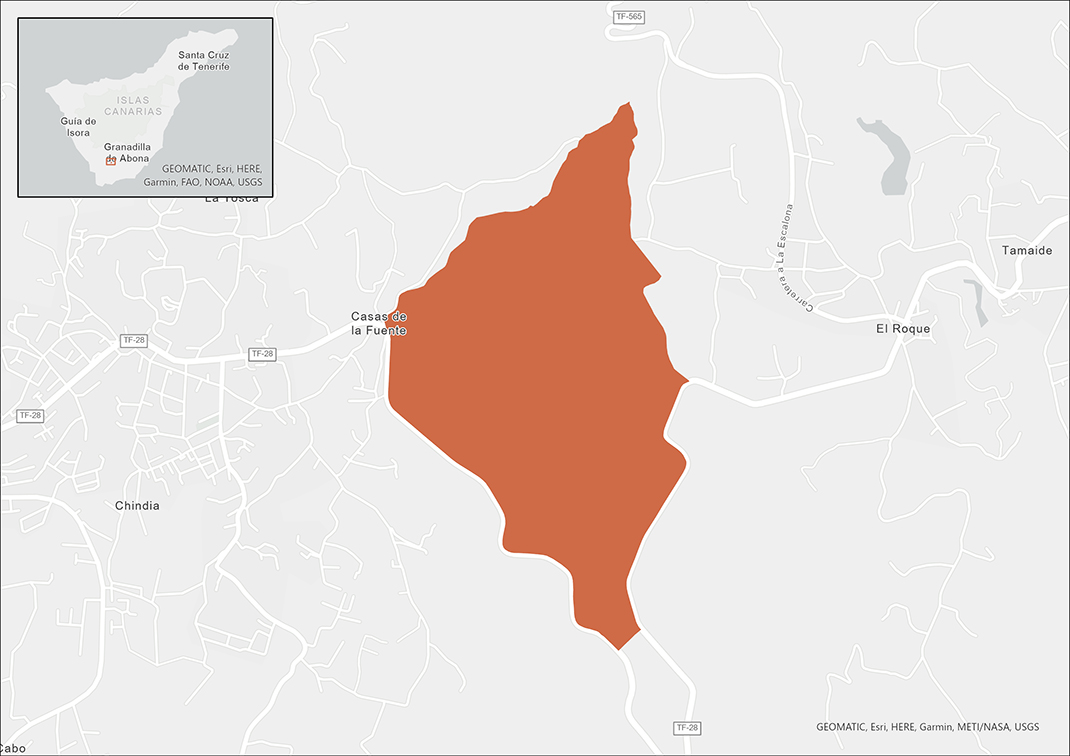Plan your next adventure
Tailor your own route along Tenerife’s trails quickly and easily..
Go to planner
Approximately 11 million years old, the Roque de Jama Natural Monument is one of the few surviving remnants of the oldest structures of the Adeje Massif, one of the three original stages in the formation of the island of Tenerife, together with the Teno and Anaga massifs.
Recommended time to visit: All year round.
El Roque is the most striking element of this great volcanic structure.
It is a volcanic plug formed by rapid cooling and high pressure acting on the magma within a volcanic vent towards the end of an eruption. The more resistant magma has been exposed by erosion over millions of years and has taken on the shape you can see today.
Its location on the southwestern slopes of the island and its unique shape make it a visual landmark for all those who live in or visit this area.
The archaeological remains found here, left behind by the island’s original inhabitants (the Guanches), bear witness to this site’s historical importance.

The vegetation is dominated by the tabaibal-cardonal plant community with some thermophilic plant species, some growing in hard to reach areas, which favours their conservation. In addition, large rock communities can be found on the cliffs in the higher areas.
Specifically, in the patches of tabaiba amarga (Euphorbia lamarckii) you will see species such as cornical (Periploca laevigata) or balo (Plocama pendula), while in the rockier areas you will find good specimens of cardón or Canary Island spurge (Euphorbia canariensis).
The surviving thermophilic species that inhabit this volcanic plug include sabina (Juniperus turbinata ssp. canariensis), acebuche (Olea cerasiformis), espinero (Rhamnus crenulata), bicácaro or Canary Island bellflower (Canarina canariensis) and retama gris (Teline osyroides). Rock plants include oreja de ratón (Aichryson laxum) and colderrisco escabrosa (Crambe scaberrima).
Meanwhile, in the abandoned farmland areas, there is a proliferation of incienso (Artemisia thuscula), vinagrera (Rumex lunaria) and marguerites (Argyranthemum frutescens).
El Roque is of great importance for birds, as it is a breeding site for the Barbary falcon, barn owl, kestrel, Berthelot’s pipit, blackbird and chiffchaff.
As for mammals, of particular note is the European free-tailed bat, which roosts in crevices and caves in the surrounding area.
Among the reptiles you will be able to spot three species: the Tenerife gecko, the Tenerife lizard, and the Tenerife skink.

94.1 ha (0.05% of the island).
Tabaiba amarga (Euphorbia lamarckii), cornical (Periploca laevigata), balo (Plocama pendula), cardón or Canary Island spurge (Euphorbia canariensis), sabina (Juniperus turbinata ssp. canariensis), acebuche (Olea cerasiformis), espinero (Rhamnus crenulata), bicácaro or Canary Island bellflower (Canarina canariensis), retama gris (Teline osyroides), oreja de ratón (Aichryson laxum), colderrisco escabrosa (Crambe scaberrima), incienso (Artemisia thuscula), vinagrera (Rumex lunaria), marguerite (Argyranthemum frutescens), Barbary falcon, barn owl, kestrel, Berthelot’s pipit, blackbird, chiffchaff, European free-tailed bat, Tenerife gecko, Tenerife lizard, Tenerife skink.
Tabaibal-cardonal, rocky habitat, thermophilic.
La Centinela Viewpoint.
To consult permits for use and updated regulations for this Protected Natural Area, visit the official website of the Government of the Canary Islands.

Tailor your own route along Tenerife’s trails quickly and easily..
Go to planner